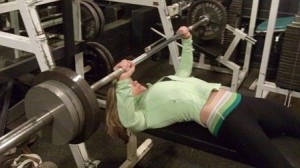 Recently, Client Wayne asked me what the merits of doing a split routine are. He wanted to know the benefits and why I happen to choose a ‘push/pull/legs’ split I talked about in this post.
Recently, Client Wayne asked me what the merits of doing a split routine are. He wanted to know the benefits and why I happen to choose a ‘push/pull/legs’ split I talked about in this post.
So settle in, you’ll find the rationale and several workout samples below.
I’ve been a gym rat for years.
In fact, more than I actually care to admit. As a competitive swimmer, I was doing dryland training since I was around the age of 10, so it’s been 40+ years that I’ve been in some sort of weight room. No wonder I feel at home there.
In 40+ years, you can imagine that I’ve tried splitting up my workouts and body parts in every possible way. I’ve done full body workouts, upper body/lower body workouts; I’ve trained complimentary body parts, opposing body parts, and every combination in between. In fact, I still use all these splits at some point, but I usually fall back on a push/pull/legs split.
For me, this is personal preference but there is a good deal of merit to it as well.
Some of you may be doing full body workouts every day. This is totally fine if you enjoy this method. However, if you’re starting to lift heavier loads, if you find your workouts longer to hit each body part, if you experience lots of muscle soreness and slower recovery, it may be time to consider breaking up your body parts.
 As I age, I find that warming up is important. Many of my colleagues, mostly large men that move a lot of weight, have had the unfortunate experience of not warming up sufficiently and have tweaked a muscle here and there. I’ve thankfully learned from their experience and (so far) have ensured that I’m extremely warm before I start moving my heavier weights. My lifts may not look like they compare to theirs, but pound for pound of bodyweight, it’s fairly comparable. I don’t need to risk injury. By using the push/pull/legs split, warming up is more targeted.
As I age, I find that warming up is important. Many of my colleagues, mostly large men that move a lot of weight, have had the unfortunate experience of not warming up sufficiently and have tweaked a muscle here and there. I’ve thankfully learned from their experience and (so far) have ensured that I’m extremely warm before I start moving my heavier weights. My lifts may not look like they compare to theirs, but pound for pound of bodyweight, it’s fairly comparable. I don’t need to risk injury. By using the push/pull/legs split, warming up is more targeted.
The benefit of doing a push/pull/legs split is that I’m able to focus on specific muscle groups. For example, if it’s a chest, shoulders and tricep day, all my pushing muscles are good and warm and I feel like I can safely trash them without risk of injury. I can still keep my workouts to under 40 minutes which is very manageable while training a particular body part with intensity.
I can also provide a longer recovery period by focusing on pulling or leg muscles on other days to allow them to rest. Recovery time is sometimes underestimated with people in that they often don’t provide enough time for their body to rest and grow. If you’re placing significant load on it, proper nutrition and rest is required to allow for recovery. Injury and lack luster performance will result if muscles are trained too hard too often. This goes for those that are a little longer in the tooth and for those that are wet around the ears.
I’m not giving you an excuse to go sit on the couch but I am suggesting that you resist the urge to get under a heavy squat bar (or any other heavy lift) daily. The body needs time to rest and since I like to train every day, splitting the body up so one area can rest while a train an opposing one is a good plan.
Here are some sample workouts that I’ve recently done using the push/pull/legs split:
- One arm DB press 3 sets (no rest between sides)
- Bench press to push ups 3 sets
- One arm shoulder press to DB lateral raises to deep dips 3 sets
- Tricep cable extentions to sit outs 3 sets
Pull Day (I wrote a blog post here about this one)
- 10 sets of 10 pull ups in a min FUW jump rope
- DB row 3 sets (no rest between sides)
- Cable pull over to cable rear delt rows to DB turned out bicep curls 3 sets
Leg Day

- Squats down the rack (read about down the rack training here)
- Start with a heavy weight to get 8-10 reps, then drop the weight two more times for 8-10 reps each time
- Do 3 sets of this (so 90 reps of squats in the end)
- DB RDL 3 sets
- Calf raises to hanging leg raises (for abs) 3 sets
I’ll usually throw in a complex or full body workout after a push/pull/legs cycle. There are a number of benefits to this. For one, I feel I can work out muscle soreness. Secondly, I love the variety this provides. And thirdly, my joints get a rest; the nature of complexes is such that I need to lighten the load to accommodate the weakest movement in the complex. The combination of the movements without putting down the weight is challenging enough without having to ‘go heavy’.
To me, this is the beauty of complexes. Movements have an entirely different feel when strung together. You can tax complimentary muscles by pre-fatiguing others. For example, if I’m doing a DB complex and string a single leg RDL (Romanian dead lift) together with a single leg DB reverse lunge, I’m going to feel my hamstrings in a way I wouldn’t if I did an RDL alone. Throw in a one leg ged burpee to that combo and my hamstrings will be singing (or maybe cursing) like crazy.
ged burpee to that combo and my hamstrings will be singing (or maybe cursing) like crazy.
Notice how I don’t have a ton of ab training here? Trust me, when doing this sort of training (push/pull/legs split and complexes), your abs will be strengthened from every angle.
If you’re looking to spice up your training, lose fat, build metabolically active sexy muscle and increase the ‘fun factor’ all in under 20 minutes, Challenge Complexes is a real winner.
If I feel I need a ‘day off’ from training, one of my favorite days is to throw in a jump rope workout with ab moves such as this:
Set the timer for 1 min work/15 sec transition:
- Jump rope
- Burpee
- Ab move (plank, plank alternate leg lift, side planks, hanging leg raises, hanging oblique raises, shoe touches, etc, change every set)
Do 5-8 rounds
My Challenge Jump Rope and Challenge Burpee programs are full of ‘fun’ stuff like this little number above. Each of these programs can be used on their own, just cycling through the workouts, or you can use them like I do, nestling them in with other formats of workouts.
The key to fitness progress is to constantly change things up. The way you split your body parts of in your workout is just another way to add variety. (I actually practice what I preach by being the guinea pig for these Challenge Workouts that I give you.)
Thanks for the question Wayne.
If anyone else has a question, shoot it off, add it to the comment section and I’ll do my best to answer with a blog post or on the Q n A.






